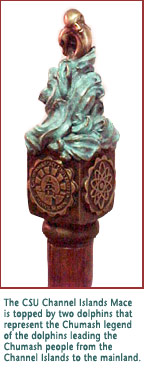The University Mace
 The
mace has a long history as a symbol
of authority. In medieval times it
was a studded, club-like weapon made
of iron and capable of breaking armor.
It came to be associated with the
protection of the king of England
and France and was carried by the
king's sergeant-at-arms. In the 13th
century it was used for civil purposes
as well, and it figured prominently
in the processions of city mayors
and other dignitaries. The mace eventually
became a symbol for academic institutions
as an emblem of order and authority
in the pageantry of ceremonial occasions.
The
mace has a long history as a symbol
of authority. In medieval times it
was a studded, club-like weapon made
of iron and capable of breaking armor.
It came to be associated with the
protection of the king of England
and France and was carried by the
king's sergeant-at-arms. In the 13th
century it was used for civil purposes
as well, and it figured prominently
in the processions of city mayors
and other dignitaries. The mace eventually
became a symbol for academic institutions
as an emblem of order and authority
in the pageantry of ceremonial occasions.
The CSU Channel Islands Mace represents the authority of the University vested in the President at official and ceremonial functions for the lifetime of the institution. Designed and crafted by renowned artists David Elder and Linda Elder of Ventura County, the Mace is an important symbol of the University, and its design reflects the spirit of the campus. The staff is carved from native walnut, signifying the growth of the University on California soil. On each of the four sides of the bronze finial is a carved medallion; these are the California State University Channel Islands Seal, the California State University Seal, an atom, and the book of knowledge. The latter two signify scholarship, research, and service to humanity. At the pinnacle of the Mace, two dolphins dance in the waves, reflecting the Chumash legend of the dolphins leading the Chumash people from the Channel Islands to the mainland.
The CSU Channel Islands Mace is a gift to the University from its 13 initial faculty members:
- William H. Adams
- Frank Barajas
- Lillian Vega-Castaneda
- William Cordeiro
- Ivona Grzegorczyk
- Philip Hampton
- Joan Karp
- N. Jacquelyn Kilpatrick
- Louise Lutze-Mann
- Dennis Muraoka
- Jack Reilly
- Kevin Volkan
- Ching-Hua Wang
